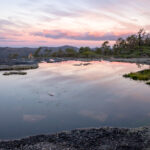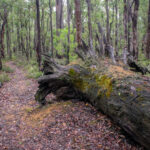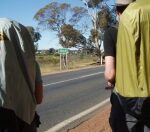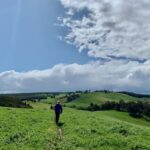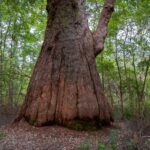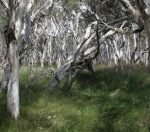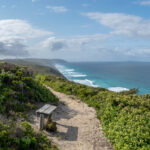Flora & Fauna
The Bibbulmun Track takes walkers through many and diverse areas of natural beauty, from jarrah forests to the cliff-tops above the mighty Southern Ocean. The terrain is ever changing and a trek through the bush becomes a journey through a huge natural garden for plant lovers to admire. But it is not only the flowers and trees that make the Track special. On the floor of the forests, in the low-lying scrub heath lands of the south, in the lakes and rivers and in the tree-tops overhead live a myriad of mammals, reptiles and birds.
This region, known as the Southwest Botanical Province, is one of the world’s 34 terrestrial hotspots for conservation priority.
In general terms the Track’s environmental habitat and species diversity can be divided into three eco-regions. Click on each region to download a fact sheet identifying some of the most common native flora and fauna likely to be seen along the Bibbulmun Track.
Darling Range Jarrah/Marri Forest Region – Kalamunda_to_Dwellingup
Karri Forests Region – Dwellingup_to_Northcliffe
South Coastal, Forest Hinterland and Wetlands Region – Northcliffe_to_Albany
We are very grateful to volunteers Cliff and Sharron Burns (aka the Bibbulbums) for researching and collating the content.

See more photos in the gallery below. Click on an image to enlarge it and scroll through the gallery.
Discover with a group
The Foundation holds wildflower walks every spring or you may wish to bring the kids to an experience and discover our native animals. These walks are part of our Calendar of Events.
The northern half – journey through the jarrah forest

The journey commences through the jarrah forest, within which there is a vast array of different types of vegetation and distinct varieties of flowering plants, and continues on across granite outcrops. Wattle is ever present in the forest and in the spring prickly moses spreads a gold carpet throughout.

Many species of orchid present vivid splashes of colour and on the granite outcrops different types of feather flower form masses of bright rust, yellow or pink at the fringe of the rock. Grass trees abound, attracting swarms of bees when they flower, and many forms of banksia can be observed.

On the granite outcrops the ornate crevice dragon may be seen, head bobbing and limbs waving, or maybe a well-developed king’s skink will be sun bathing on the warm rock. Fantail wrens often keep walkers company as they flit along from bush to bush or arrive in the shelters in search of food. North of Dwellingup, tall blackbutt trees surround Boonerring Spring, a permanent water hole at which honey-eaters, wrens, wattle birds and many other species are to be found, squabbling amongst themselves.

South of Dwellingup the forest areas offer a diversity of tree types, with stands of wandoo interspersed amongst the jarrah and marri trees. The Murray River is bounded by melaleuca thickets and flooded gum woodlands. South of Dwellingup, the Murray campsite is situated by a tranquil pool in the river where ducks nest in the spring and black cockatoos are often seen in large flocks in the overhanging trees. Many species of flowers show up their brilliant colours on the forest floor and in the upper storey.

Further south toward Collie, the Track wends it way across a swampy area known as the Plonkhole, where the vegetation is chiefly paper-barks and flooded gums, and then through sand flats dominated by banksia, grass trees and melaleuca, home to many small reptiles.

The section from Collie to Balingup has a mixture of heavily logged areas and stands of virgin trees. The virgin jarrah trees are giants of their kind and are a reminder of the vast forests that existed before the arrival of the European settlers. There are many creeks crisscrossing the area and in the spring the wild flowers are particularly prevalent. As more southerly latitudes are reached soap bush and rushes appear along the creek beds, a sight more commonly seen in the southern karri forests.
Near Balingup walkers pass through a stand of wandoo, a tree more commonly found further to the north. As always in the forest, many species of birds abound and the forest floor is a home to small animals, reptiles and insects.

Immediately south of Balingup the Track passes through the Golden Valley Tree Park, which contains many examples of beautiful trees from all over the world, and then through the pine plantations of the Blackwood Valley. The vegetation undergoes some dramatic changes now, as the first karri trees are encountered and the forest becomes damper and more dense. Fungi are plentiful and as always orchids and other brilliantly coloured flowers can be found in the understorey and on the floor of the forest. Flashes of colour are also apparent as parrots and rosellas squabble in the treetops.
Beyond the half-way mark – into karri country

Donnelly River Village, once a timber town and now a holiday village, is a place where walkers can get very close to an extraordinary collection of semi-tame kangaroos and emus. Blue wrens are a common sight and flocks of “28” parrots gather on the roof tops of the houses.

Male Splendid Fairy Wren by Mark Davidson.
Heading south towards Pemberton the Track passes through some beautiful areas of blackbutt (yarri) and initially follows the Donnelly River along narrow trails bordered with soapbush. In the spring the area is a blaze of colour, all topped by the magnificent karri trees which begin to dominate the forest. One of the highlights of this section is the Beedelup Falls, which crash down over the granite through a series of pools.

Closer to Northcliffe the Track wends its way along the Warren River valley into the Northcliffe Forest Park, where walkers will find an abundance of wildflowers in the spring. The forest is generally damper, with associated plant life, such as ferns, abundant and the presence of water along most of the route also means the bird life is prolific. Quokkas, small marsupials found mainly on Rottnest Island near Perth but once widespread on the mainland before the introduction of foxes, have been spotted along this section. Indeed their numbers are increasing through Operation Fox Glove.
The plains and forest before the coast

Between Northcliffe and Walpole spans a long section of almost 140km with terrain varying from karri forest to swampland, coastal dunes, beaches and back to the forest, this time to the mighty tingle trees.

Water, in the form of the Gardner and Shannon Rivers and Lake Maringup, is a close companion early on and then walkers find themselves in the flat, swampy lands of the Pingerup Plains. The Track passes through stands of karri, Warren River cedar and sheoak trees and across granite mounds, before reaching the dunes and sand ridges with their mix of peppermint and banksia scrub. Quite suddenly the ocean appears ahead, followed by the beautiful view of Mandalay Beach. The Track then turns inland again to give walkers their first sight of the tingle trees, native to only this small pocket of land around the town of Walpole.
The final frontier – the wild south coast

Many walkers consider this section a favourite, due to the tremendous variation of flora and fauna along the way. Starting amongst the giant karri and tingle trees the Track turns back towards the coast, passing through stands of red flowering gum and coastal sheoak before turning on to the long sandy ridges of the dunes and cliff tops bordering the south coast.

Before reaching the beach once more, walkers encounter the “Showgrounds”, a strange area of open heath and grasslands, home to many kangaroos, emus and a vast number of wild flowers in the spring. Finally the Track rises over the granite mound of Mount Hallowell and descends into Denmark.
After crossing the Wilson Inlet at Denmark, home to a host of bird life, this final section of the Track combines some fine cliff top walking with a stretch through the West Cape Howe National Park. The hardy coastline vegetation offers some colour throughout the year, combined with spectacular views of the rugged cliffs and the myriad of colours in the Southern Ocean.
There have been reports of sightings of the rare and elusive ground parrot in this area and the low lying shrublands are a haven for snakes, especially the western tiger snake. Flies can be a hazard in the summer and other flying insects provide food for many bird species which live in the coastal heathlands. More bird life can be seen along the traverse of Princess Royal Harbour as walkers arrive in Albany – the Southern Terminus.
You’ll find a great range of small interpretation books to take on your walk in our shop including A Wildflower Guide of the Northern Bibbulmun Track and Jarrah Forests.
For further information regarding the South-West Botanic Province visit:
dpaw.wa.gov.au/plants-and-animals
florabase.dpaw.wa.gov.au

